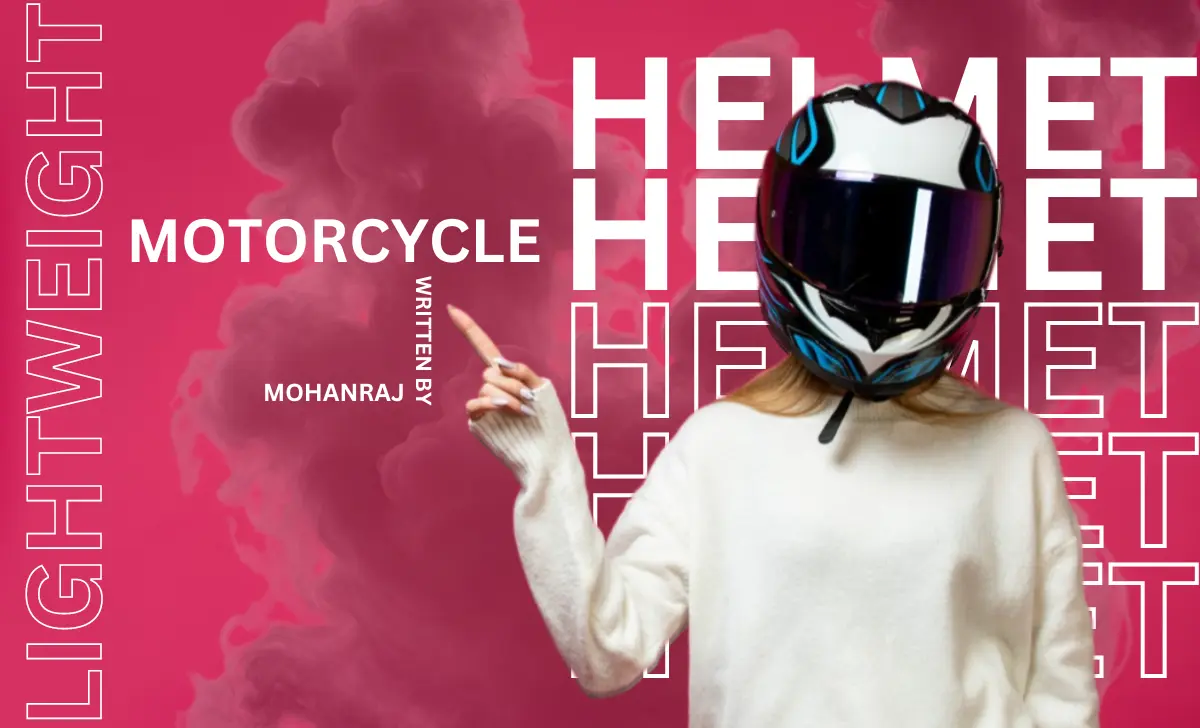
Enhance Your Riding Experience with Lightweight Helmets
Welcome, fellow riding friends, to my lightweight helmet safety blog! As an avid motorcycle enthusiast with over 20 years and hundreds of thousands of miles under my belt, I understand firsthand how essential proper protective gear can be out on the open roads. Especially a quality, well-fitted helmet designed specifically with your riding style and priorities in mind.
After enduring my fair share of spill-testing limits over the years, I started this blog to help bikers like you make smart, informed choices when investing in this life-saving headgear. As technologies advance, options seem to expand exponentially year over year, making narrowing down the best motorcycle helmet for your needs a dizzying endeavor! Well, you’ve come to the right place.
My goal is to provide an exhaustive, unbiased resource exploring the mold-breaking innovations hitting the motorcycle helmet industry today and cutting through the marketing noise to distill down to what truly matters most: maximizing safety and comfort tailored to your riding passions.
Together, we will unpack the leading designs on the market right now across adventure, sports, modular, electric, retro, and more. I’ll leverage first-hand testing experience from the road and track to spotlight key considerations—from intended use, certifications, weight, sizes, features, and beyond—to dial in your perfect match. There’s also a whole community of fellow riders here, ready to engage and lend their insights as well.
So whether you live for featherlight open-face freedom or demand integrated smart navigation bundled into maximum high-speed impact protection, let’s get you geared up and out enjoying the ride ahead!
In this article
The Importance of Motorcycle Helmet Safety
Riding a motorcycle comes with inherent risks, which is why proper safety gear, especially helmets, is crucial. The right helmet can greatly reduce the likelihood of a serious head injury in the event of an accident. While all helmets sold in the US meet DOT standards, considerations like weight, fit, and features play a role in finding the optimal choice to meet your needs and riding style.
The Evolution of Motorcycle Helmet Technology
Motorcycle helmets have come a long way since the early 20th century when leather and cork were used more for wind protection than impact absorption. Key milestones in motorcycle helmet evolution include:
- 1953 – The first patented modern motorcycle helmet with a rigid outer shell and inner padding is invented by Charles F Lombard. This paved the way for future safety innovations.
- 1970s Onward – Advancements in materials like fiberglass and polycarbonate usher in stronger, lighter helmet designs. Computer-aided design software also enables a more customized, precise fit.
- The 2000s – Continued focus on weight reduction techniques while maintaining safety standards. Some of today’s helmets weigh less than 2 pounds.
Ongoing innovations in materials, aerodynamics, and smart technology point to even safer and more advanced helmets on the horizon.
Choosing the Right Motorcycle Lightweight Helmets
With so many motorcycle helmets on the market today, it can be challenging to determine which one is right for your needs and budget. Here are key factors to consider:
Safety Certifications
- DOT – The legal minimum standard required for all helmets sold in the US.
- ECE 22.05 – A widely accepted European standard that is generally more stringent than DOT.
- Snell M2020 – Non-profit certification denoting high-performance helmet safety beyond minimum requirements.
Reputable Brands
Well-established brands known for consistent quality and safety:
- Shoei
- Arai
- Shark
- AGV
- Scorpion
- HJC
Model Comparisons
Compare specific helmet models based on:
- Intended use (street, track, etc)
- Weight
- Ventilation
- Features like Bluetooth, sun visor, etc.
- Price point
Comfort and Fit
An uncomfortable helmet is less likely to be worn properly. Seek out features like:
- Removable/washable interior lining
- Flow-through ventilation to regulate temperature
- Easily adjustable retention system for secure fit
Tips for Long-Distance Motorcycle Riding
For riders planning longer motorcycle trips, choosing the right gear and preparing adequately is key to a safe and enjoyable ride:
Packing Essentials Ensure your helmet fits comfortably for extended wear. Pack backup components like visors and padded linings in case replacements are needed after long days of riding. Choose a modular helmet if you prefer flipping up the front while refueling or taking breaks.
Comfort Items
Carry earplugs to minimize wind noise and fatigue. Pack a soft cloth to wipe visors if they get dusty/foggy. Choose a helmet with good ventilation for airflow and temperature regulation. Apply an anti-fog treatment to the interior visor.
Electronics
Hands-free Bluetooth systems allow GPS instructions to relay directly to your helmet. Pack backup batteries/charging cables for electronics. Waterproof smartphone pouches protect devices from the weather while enabling quick access.
Safety Gear
Any loose items should be secured with elastic bands or velcro. Affix reflective strips to helmets to remain visible to other vehicles in low light. Bring an extra face shield or goggles in case of damage.
Emergency Essentials
Always carry basic tools, first-aid supplies, tire repair kits, and an emergency contacts list. Share your route details with friends/family.
Preparing adequately takes time but enhanced comfort, safety, and convenience during long-distance rides is worth the effort.
Maintaining Your Motorcycle Helmet Properly
A quality motorcycle helmet is a significant investment for any rider. Proper maintenance and care ensure your helmet provides reliable protection each ride. Best practices include:
Regular Cleaning
Clean the helmet frequently with mild soap and lukewarm water to remove dirt, sweat, and grime that can speed up material degradation. Let the helmet fully air dry afterward.
Inspection and Replacement
Inspect for signs of damage before each ride. Plan to replace your motorcycle helmet every 5 years or after any significant impact. Over time, protective capacity declines even without visible wear.
Importance of Weight in Motorcycle Helmet Design
A lightweight motorcycle helmet provides key advantages that enhance the riding experience:
Reduced Neck and Shoulder Fatigue
Less strain over hours in the saddle enhances comfort and concentration.
Minimized Turbulence and Wind Noise
Lighter helmets allow for better stability at high speeds and less noise fatigue.
As technology progresses, motorcycle helmet weight reduction remains a priority while upholding rigorous safety standards. Advanced materials and aerodynamic engineering play pivotal roles in achieving both goals.
Innovations in Motorcycle Helmet Technology
As with most technology today, motorcycle helmets continue to evolve with innovations that aim to make rides safer and more enjoyable. Some trends on the horizon include:
Integrated Smart Helmets
Premium models incorporate helpful features right into the helmet, like:
- Embedded Bluetooth for phone, GPS, and audio connectivity
- Integrated head-up displays for navigation, vehicle data and alerts
- Built-in cameras to easily capture photos and video of your trips
Having information and controls at your fingertips without the clutter and distraction of external gadgets provides an enhanced experience to stay focused on the ride itself.
Use of Sustainable Materials
Eco-conscious materials make their way into motorcycle helmets, such as:
- Recycled plastics
- Plant-based composites like bamboo
- Renewably-sourced biomaterials
Not only are these options better for the environment, but they are often very lightweight while still meeting strict safety standards. 3D printing customization also reduces waste.
Buying Guide: Lightweight Motorcycle Helmets
When investing in a new lightweight motorcycle helmet tailored to your specific needs, keep these tips in mind:
Get Properly Fitted
Measure your head circumference to determine the correct sizing based on individual manufacturer charts. An improper fit impedes safety and comfort.
Set Your Budget
Lightweight helmets span a wide range of pricing levels. Determine what technology and features suit your riding style and budget. Consider the frequency of use.
Read Reviews
Look to expert testers and fellow riders for real-world feedback on comfort, noise levels, airflow, and other factors unique to a particular lightweight helmet model.
Prioritizing Safety and Comfort
Finding the optimal balance of safety, weight, features, and value takes research. Ultimately, choosing the right lightweight motorcycle helmet comes down to personal fit and priorities. Take time to try on different models before deciding. Your safety depends on it.
Conclusion and Encouragement
After taking this comprehensive journey through the world of motorcycle helmets, one truth stands clear: protection and comfort should be the top priorities for any rider. While style and integrated add-ons provide the icing on the cake, never compromise on safety standards or a proper fit.
Your helmet is the single most important piece of gear protecting that invaluable asset on your shoulders—your head and brain. With continual advancements in materials, customized fit, and technology, today’s helmets can handle formidable impacts while allowing you to focus on the joy of the ride itself.
I hope reviewing key considerations around intended use, certifications to look for, understanding sizing variances across brands, smart functionality being integrated, and future sustainability trends provides a helpful foundation for navigating the vast motorcycle helmet marketplace today. While investment upfront seems costly, it pales compared to the alternative.
Now that you’re armed with insight into this essential riding gear, it’s time to try on that perfect match! Trust the process. The ideal lightweight helmet balancing top-tier safety, ergonomics, and features tailored to your unique riding passions awaits somewhere. Here’s to many happy trails ahead together, friends!
As always, drop any lingering questions in the comments below. Let’s keep helmet education and community support rolling. Ride on!




